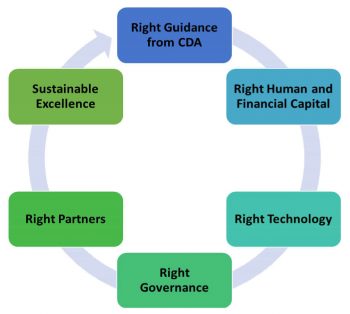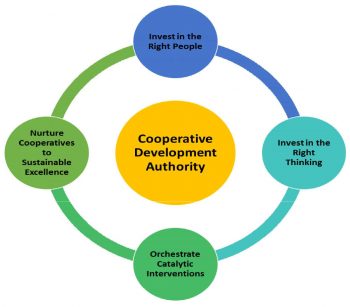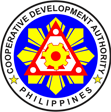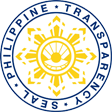
OVERVIEW, VISION, GOALS AND PRINCIPLES
Nation-building, for all the strides and struggles we have made, is an unfinished business. And even as we begin to reap the fruits of economic and socio-political reforms, our people would always deserve more as they look upon leaders from government and from the cooperatives to lead and move them forward.
The ultimate test of good governance then is to free every Filipino from the persistent threats of hunger, disease, crime and repression, environmental degredation and to nurture in everyone the will, the drive and the energy to dream and achieve the vision for a just, humane, progressive, and secured country.
The Cooperative Development Authority (CDA), pursuant to its mandate as the lead agency for the promotion and development of cooperatives and in consonance with its function to formulate, adopt and implement integrated and comprehensive plans and programs on cooperative development consistent with the national policy on cooperatives and the over¬all socio-economic development plans of the government, initiated the formulation of the 2018-2022 Philippine Cooperative Development Plan.
The plan is a result of multi-sectoral efforts. It highlights the importance of developing mutually-empowering partnerships focused on sustained efforts to address needs, problems and poverty at its roots. It attempts to address not only the lack of material resources or income, but also the absence of capabilities, opportunities and power that will allow the individual to fully assume her/his role as a member of the community.
Vision
The Philippine Cooperative Development Plan for 2018-2022 is anchored on a collective vision of the cooperative sector which is1 : “Towards a Globally Competitive and Resilient Cooperative Industry for A Progressive Nation”.
Goals
Cascading from this vision is the cooperative sector’s strategic goals which are:
- Enhanced Policy, Regulatory Environment and Partnerships;
- Improved Institutional Development, Governance and Management;
- Sustained Human Capital Development among Cooperatives;
- Globally Competitive Cooperative Products and Services;
- Increased Access to Finance; and
- Increased Access to Markets and Infrastructure
Principles
The realization of the collective vision and strategic goals of the cooperative sector will contribute to the societal goal of poverty reduction and the improvement of the quality of life of the members of cooperatives. Therefore, the operations and governance in the cooperative sector as well as the relationships between and among the actors shall be guided by the following principles: a) subsidiarity and complementation, b) circumscribed governance, c) empowerment, d) strategic alliance and critical collaboration and e) accountability.
1. The principle of subsidiarity and complementation
This principle espouses that that the State should, whenever and as long as possible, leave to private initiative, the affairs of the market. It recognizes the private sector as the engine of growth and development with the State providing the facilitative and enabling environment. Under this principle, the State does not take over the affairs of business enterprises in the market but encourages and supports these enterprises so that the latter can effectively exercise their role as major players and primary engines of growth, stability and equity.
2. Principle of Circumscribed Governance
This principle is based on the realization that State has limited resources to fund the provision of public goods and services thus the government allows itself to be circumscribed by the following: the citizen’s basic rights, basic obligations, the financial system, the judicial system, well-defined public goods and by limited resources. Thus, from playing basically a regulatory role, government becomes a facilitator of private initiative.
Government plays a leading role in setting the broader institutional environment for business behavior through the provision of the appropriate incentive structure to which economic agents respond. On the other hand, the private sector’s ability to function depends critically on the reliability and effectiveness of institutions to provide the necessary public goods such as guaranteeing the rule of law or the protection of property rights.
3. Principle of Empowerment
The principle recognizes that the principal responsibility of peoples to chart their own development and destiny rests in themselves with the State providing measures to facilitate the same. This principle espouses that most vulnerable sectors of society be economically empowered by expanding their capabilities and opportunities to generate sustainable sources of income, propagating awareness for possible collective action, and increasing their participation in decision-making.
4. Principle of Strategic Alliance and Critical Collaboration
This principle is premised on the realization that governance is not the sole domain of government; that there are two other important actors as well, namely: the business sector and civil society. While the business sector as an actor is easily understood, civil society needs to be defined to be well appreciated. Thus, civil society refers to the multitude of associations around which society voluntarily organizes itself to advocate and take action primarily for social development and public interest. It includes, among others, non-governmental organizations, peoples’ organizations, the academe, civic clubs, trade unions, gender, cultural and religious groups, professional associations, academic and policy institutions, consumers’ organizations and the media.
The principle of critical collaboration recognizes the full, substantial, independent but intersecting and reinforcing roles and partnerships of key actors in the cooperatives sector.
5. Principle of Accountability
The principle of accountability refers to the responsible use of power, by the leadership and by the institutions to advance the general welfare. It requires that those who hold positions of public trust should account for their performance to the public. Effective accountability requires appropriate external feedback and should be linked to appropriate incentive and penalty.
In light of the abovementioned cooperative sectoral vision, and principles, and the Cooperative Development Authority’s mandate of promoting the viability and growth of cooperatives as instruments of equity, social justice and economic development, the CDA in partnership with other stakeholders shall work hand in hand with the cooperatives in pursuing the strategic goals in the 2018-2022 PCDP.
Flywheel of Values
The “Flywheel” is a very useful analogy for implementing business strategy created by Jim Collins. It describes how driving a new strategy is like getting a huge flywheel into motion. Initially, there is no movement – many people think that the strategy is absurd – it is almost impossible to imagine the flywheel at speed. With great exertion of will, the CEO is able to deliver some results that get the flywheel moving. They appear small and trivial initially, but create the credibility to move to more ambitious results. As more and more results accumulate, more and more people throw their weight behind the wheel and the momentum of the flywheel builds and builds.
A. Flywheel of Value of the Cooperative Industry

The cooperative industry flywheel was developed from the analysis of the strengths and risks of the cooperative industry’s value chains based on the regional consultative workshops conducted in the second semester of 2017. The first attempt of the cooperative industry to use the flywheel framework for action, although the output can still be refined, was encouraging as it allowed the participants to quickly focus on the essential elements and a great start for spinning the industry’s actionable items towards sustainable excellence.
B. The CDA’s Flywheel

The first element in the flywheel (Investing in the Right People) mirrors CDA’s strength in people. To ensure that CDA’s low influencing strength gap is addressed, the verb invest is added to the first element to mean proactively seeking the right people with strengths in influencing.
Likewise, the fourth element of the flywheel leverages on the same strength in people. The second and third elements (Invest in the Right Thinking and Orchestrate Catalytic Interventions) both pertain to resolutely closing CDA’s organizational gaps in thinking and action.
CDA’s core strength are its capacity to provide strategic counsel, and build lasting relationships.2
Overall, what the synergy of strengths and strength gaps clearly highlight, is the importance of CDA’s role in jumpstarting the cooperative industry’s flywheel. It becomes imperative therefore, that all efforts should be taken to ensure that the CDA’s Flywheel spin as fast.
Monitoring and Evaluation
In carrying out the 2018-2022 Philippine Cooperative Development Plan, the CDA will utilize a results-based management approach, the use of which constitutes a shift from focusing on activities to focusing on results. This result’s-based approach will also form the foundation of CDA’s management and evaluation system.
The Results framework was developed, vetted and finalized by the 2018-2022 PCDP Technical Working Group. The results within this framework are designed to reflect the CDA and the cooperative sector’s manageable expectations over a five-year time frame.
THE PLAN
Strategic Goal 1:
Enhance Policy, Regulatory Environment and Partnerships
Desired Outcome 1:
Inter-government coordination and cooperation is strengthened to create an enabling environment for the growth, development and regulation of cooperatives through an enhanced consultative mechanism
Options for Action
- Policy Review and Enhancement;
- Communication Program of Laws. Rules and Regulations and Policies for Cooperatives and other Stakeholders;
- Continuing Regulatory Policy Review and Enhancement Program;
- Regulatory Impact Assessment; and
- Creation of an International Network for Registrars and Regulators with assistance from the International Cooperative Alliance
Strategic Goal 2:
Improved Institutional Development, Governance and Management
Desired Outcome 1:
Increase in the number of cooperatives achieving excellence
Options for Action
- Gawad Parangal (GP);
- Documentation of Cooperative Best Practices; and
- Modeling of Cooperative Good Governance and Ethical Practices
Desired Outcome 2:
Deeper internalization of cooperative identity and increased awareness by cooperative members, officers and management of their privileges and duties
Options for Action
- Cooperative Education Program (Ideology, Philosophy, Values, Principles);
- Inclusion of cooperative education within the curriculum at all stages of education and in broader promotion in the business schools and professional bodies;
- Development of guidelines on how to monitor the application of the cooperative principles by cooperatives;
- Establishment of a cooperative knowledge data bank to measure and demonstrate impact, facilitate knowledge transfer and as an advocacy tool for policy makers/ legislators; and
- Monitoring of public reception of cooperative messaging through surveys4
Strategic Goal 3:
Promote Human Capital Development among Cooperatives
Desired Outcome 1:
Professionalized Human Resources
Options for Action
- Management and/or Technical Skills Program for Officers and Members of Cooperatives;
- CDA Cooperative Education and Training Programs;
- Accreditation of Training Providers and Improve Access to Good Quality Training Services;
- Partnership with Relevant Agencies on Capability Building Projects;
- Platform to promote and facilitate the Participation of Women, Persons with Disabilities (PWDs), Elderly and the Youth in Cooperatives;
- Inclusion of cooperative youth development programs in the Cooperative Development Plan;
- Inclusion of allocation for the education and training fund for youth programs to support the activities, goals and plan of laboratory cooperatives; and
- Encouragement of cooperatives to allow a seat in the Board of Directors for a youth representative to incorporate the goals and plans of the youth sector to the cooperative leadership
Desired Outcome 2:
Strengthened Co-operative Education System
Options for Action
- Establishment of an Eco-system for National Cooperative Education System;
- Formulation of a Strategic Cooperative Education Development Program; and
- Establishment of a Central Library and Historical Archive for Philippine Cooperatives
Strategic Goal 4:
Globally Competitive Cooperative Products and Services
Desired Outcome 1:
Application of Appropriate Technology and Innovation in Cooperative Enterprises Options for Action 1. Increased Use of Science Technology and Innovation Promotion Program; and 2. Promotion of a systemic approach to risk management among cooperatives Desired Outcome 2: An efficient system of data/information gathering, storage, retrieval, processing and dissemination is established Option for Action 1. Creation of National Cooperative Data and Information Repository System
Strategic Goal 5
Increased Access to Finance
Desired Outcome 1:
Institutional framework for access to financing will be developed and enhanced
Options for Action
- Financial Literacy Training Program for MSMEs, Cooperatives and Overseas Filipinos (OFs);
- Capacity building on the preparation of “good” proposals; and
- Adoption of measures to stimulate internally-generated capital5
Desired Outcome 2:
Improved policy environment to foster alternative and non-traditional financing
Option for Action
- Creation of an Enabling Policy Environment to Foster both Traditional and Non-Traditional Financing Schemes
Strategic Goal 6:
Increase Access to Markets and Infrastructure
Desired Outcome:
Maximize opportunities that expand access to existing and new markets
Options for Action
- Improvement in the Quality of Goods and Services of Cooperatives by Adopting Best Practices to Increase their Capacity to Meet Requirements of Buyers;
- Intensification of the Promotion and Marketing of Cooperative Products;
- Development of new businesses for farmers and cooperatives like agro-tourism, environmental services, etc.6;
- Setting-up of a web-based information platform for inter-coop business matching; and
- Support for attendance to business fora and business matching events
1 As culled from the results of the PCDP 2018-2022 Regional Consultations
2 Gallup’s Strength’s Finder 2.0 was the technology used to extract CDA’s team strength profile. The results revealed CDA’s dominance in the area of strategy and relationship building and very low score on influencing. Management by Virtues Organizational Strengths-Gap Diagnostics was the tool used to determine CDA’s organizational strengths profile.The results show CDA’s strength in making a distinctive impact to the cooperative Industry, and in attracting the right people who are committed to serving the industry.
3 Adopted from the ICA Blueprint for a Cooperative Decade
4 Adopted from the ICA Blueprint for a Cooperative Decade
5 Adopted from the ASEAN Roadmap for Enhancing the Role of Agricultural Cooperatives in the Global Value Chain (2018-2025)
RESOURCES:
PCDP 2018-2022





